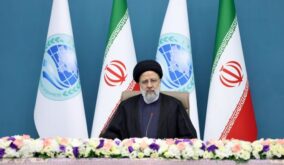Al-Monitor – Iranian authorities aided by notorious judges have started carrying out execution sentences against protesters as demonstrations approach their fourth month and pose one of the most serious challenges to the ruling theocracy in Iran.
To date, two protestors have been executed, eleven are sentenced to death row and six have been slapped with charges that are punishable by a death sentence.
Last Thursday, 23-year-old Mohsen Shekari was hanged pre-dawn in Tehran after being convicted of “waging war on God,” which judges saw in his blocking of a road and injuring a pro-government Basij militia member.
Only a few days later, Majid-Reza Rahnavard was executed in the conservative city of Mashhad, where he was found guilty of “killing” two Basij members. With only 23 days between the day of his arrest and the day of his execution, Rahnavard’s trial marked one of the speediest in Iran’s history and underlined earlier concerns that Iran was refusing to follow due course in the prosecution of dissidents.
The second protester’s “confessions” were aired on state television with a fractured and bandaged arm further fueled arguments about the torture of detainees for the purpose of confessions and ultimate execution, a policy the Islamic Republic has long practiced to convince loyalists about its “firmness,” even if there is little evidence to prove the arrested individual’s guilt.
As opposed to Iran’s own penal code, Rahnavard’s family was reportedly kept in the dark about the timing of the execution. Hours after the execution was carried out, they were only given the location of the grave where he had been buried.
While the two executions continued to draw condemnation, the Islamic Republic prepared to carry out the same on a number of other protesters. In recent weeks, Iranian judges have handed nearly a dozen more protesters that very sentence over their varying forms of participation in the demonstrations, from allegedly causing injury to security forces to such acts as setting fire to litter bins and throwing stones.
Amnesty International and Iranian rights advocacy groups have expressed concern about nine others who have been formally indicted with charges punishable by death.
#SamanSeydi (Yasin), a young rapper and protester from Iran’s persecuted Kurdish minority, has been moved from Evin Prison in Tehran to Raja’i Shahr prison in Karaj, sparking fears that his death sentence has been upheld and the authorities are preparing to execute him. pic.twitter.com/HGORShp8Gw— Amnesty Iran (@AmnestyIran) December 12, 2022
Weeks before the two executions, the Norway-based Iran Human Rights, which has been tracking the ongoing unrest, urged “timely action” from the international community. The group described execution orders as “a tool of repression” at the hands of Iranian authorities.
Who are some of the protesters on death row?
In one highly contested case, Iranian authorities have prosecuted 15 people and given five of them execution verdicts over the death of one Basij member in the city of Karaj. Eleven defendants, among them three minors, were sentenced to jail terms of up to 25 years.
Among the five is 26-year-old Hossein Mohammadi, a theater artist and the best actor award winner of a national students’ festival. In a message of support for the artist, internationally known director Saeed Rousatee lamented the verdict against describing him as someone who “cannot even play violence [on stage], let alone commit it at a level deserving the death penalty.”
Another defendant standing trial is Sahand Nour-Mohammadzadeh, 26, who according to the Human Right Activists News Agency, was prosecuted based on videos showing him among a group of protesters who had blocked a road in Tehran in September. Nour-Mohammadzadeh has rejected accusations that he uprooted a street metal barrier and burned a litter bin, based on which he has been given capital punishment.
A BBC report, citing sources close to the family, says interrogators performed three “mock executions” on Nour-Mohammadzadeh to give him the impression that he was indeed about to be hung, all to pressure him into confessions.
“The face is telling, this one has to be executed,” Nour-Mohammadzadeh quoted his prosecutor’s words upon the first encounter during a phone conversation with his family.
Mohammad Borughani is facing death following an indictment based on footage showing him chasing a Basij militia member away from a protest site.
Among the more familiar individuals feared to be given an execution verdict is popular and outspoken rapper Toumaj Salehi, whose arrest has drawn widespread fury and solidarity from new-generation Iranians. Known for his scathing anti-government songs, Salehi repeatedly called on Iranians to join the protest movement. In one video he was seen walking in a neighborhood shouting for locals to come out and join the cause. Prosecutors have found those calls tantamount to “waging war on God” and “corruption on earth.”
Similarly, Kurdish rapper Saman Seydi (Yassin), 27, was reportedly subjected to severe torture before confessing to the same charges. “Saman has not caused even a bruise to anyone,” said his lawyer, who has been rejected by the court.
Iran’s judiciary chief Gholam-Hossein Mohseni Ejei boasted about the trial of “riot leaders” being conducted in “a really short time,” a comment seen as proof to earlier assertions about “sham” and “kangaroo” proceedings. Following the first two executions, the chief justice heartened the judges to carry on “undisturbed by rebukes.”
Activists have also pointed out the long-standing issue of the Iranian judiciary’s denial of requests by dissidents for independent lawyers, a pattern that has characterized political trials since the 1979 inception of the Islamic Republic. The arrested protesters, they say, are either tried in the absence of lawyers or are strictly represented by judiciary-appointed ones, who are most often believed to be retired judges themselves.
Confirming the same, prominent lawyer Mohammad Hossein Aghasi wrote on Twitter that his application to represent the family of another death row inmate, Mohammad Mehdi Karami, has been declined by the judiciary.
Karami’s father told the Reformist paper Etemad that even the court-appointed lawyer “is not picking up our calls” for assistance, as he highlighted the incommunicado situation. “I go to bed every night fearing to wake up with the news of my son’s execution.” The defendant has told his family of repeated “sexual harassment” and threats of “rape” during interrogation.
Notorious judges calling the shots
Judges who have long engraved images of ruthless enforcers of the ruling establishment are currently leading most of the protester trials. Among them is US- and EU-sanctioned Abolqasem Salavati, whose “dreadful” impression many former political prisoners have been sharing for years on social media.
Known for his close ties with the intelligence apparatus, Salavati has a long list of death verdicts in his career, including that of dissident journalist Ruhollah Zam, who was lured into an Iraq trip by security operatives before being transferred to Tehran, where he was sent to the gallows by Salavati’s verdict in 2020. The shadowy figure has even reportedly earned the nickname “Mr. Execution” among his own colleagues, according to some accounts.
Another judge is Iman Afshari, who has issued a total of 550 years in prison sentences during his limited career. In 2019, he convicted women’s rights activist Saba Kord Afshari to 24 years in prison for joining an anti-hijab campaign. While Iran’s Supreme Court challenged the verdict after the activist’s appeal, the judge’s push is believed to have led to a new seven-year sentence, which she is currently serving.
The appointment of those judges has raised worries among moderate figures. This “will only further spark domestic and international blowback and could thrust the Islamic Republic into an irreversible situation,” wrote veteran journalist Ahmad Zeidabadi, who highlighted the typical “overexcitement” of those judges in issuing death penalties.
Yet the pressure from hard-liners, including the majority of the Iranian parliament and state media, has been relentless as they continue to press for “zero-tolerance with rioters” demanding “merciless verdicts” and “maximum punishment,” which commonly refers to the death penalty.
“The death verdicts must be carried out as soon as possible to have an impact,” said Jalili Mohebbi, a conservative cleric and former chief of the hijab policy-making body known as the Headquarters for the Promotion of Virtue and Prevention of Vice.
Three ultraconservative lawmakers have welcomed the execution drive, one describing it as “auspicious,” another noting that the society is “thirsty” for capital punishments, and the third demanding that protesters be hanged within five to 10 days into their arrests.
But almost equally relentless has been the battle waged by activists to amplify the ordeal of the individual prisoners and try and have their verdicts suspended by sharing their names and dragging them out of obscurity.
“Let’s act promptly before it’s too late so that authorities won’t be able to randomly find heads for empty gallows,” they said, highlighting the perceived absurdity and political nature of the current death penalties. The statement made reference to a famous plea in 2020 by executed wrestler Navid Afkari, who has become one of the icons of anti-government dissidence.
 Shabtabnews In this dark night, I have lost my way – Arise from a corner, oh you the star of guidance.
Shabtabnews In this dark night, I have lost my way – Arise from a corner, oh you the star of guidance.



